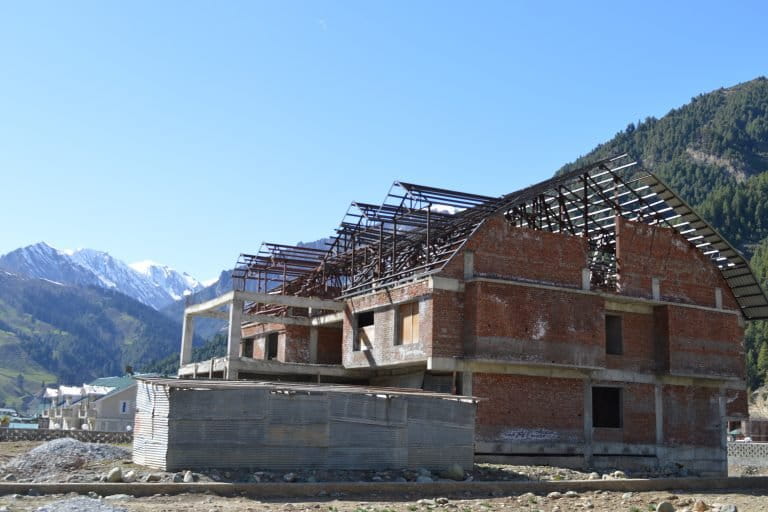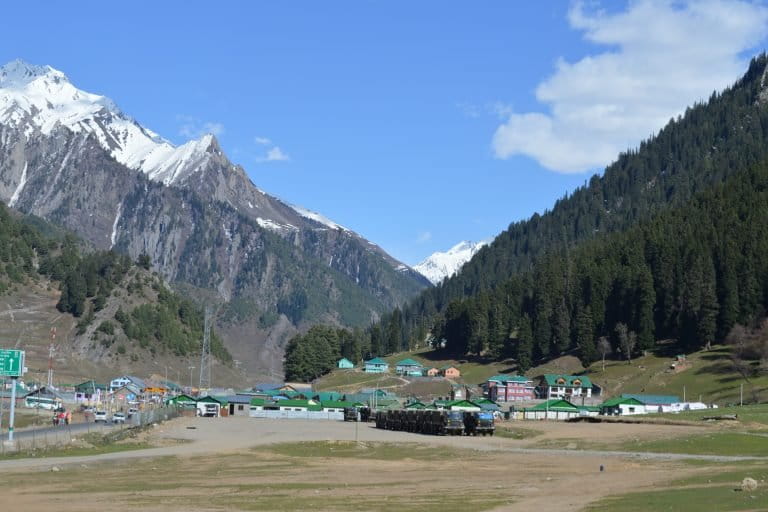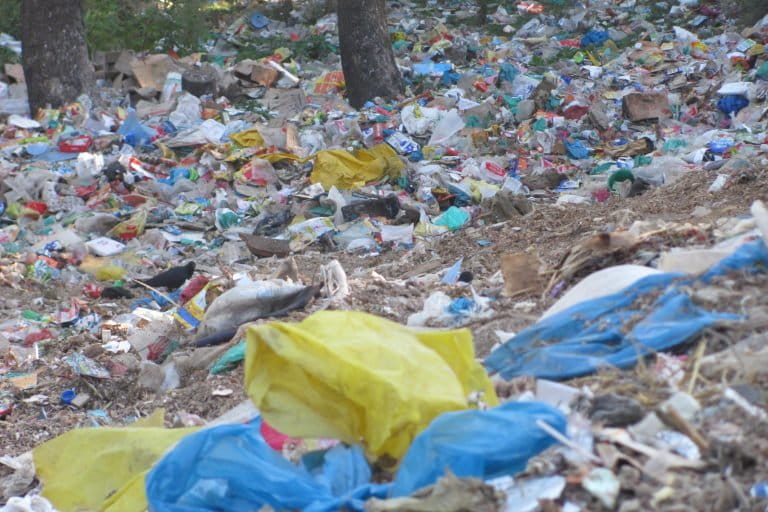- Tourism has revived in the Kashmir Valley but lack of planning, haphazard construction and no waste treatment systems are a threat to the mountain resorts of Sonamarg, Pahalgam and Gulmarg.
- The master plan for Kashmir’s Sonamarg mountain resort has been designed after 96% of the area is already under unplanned development and construction.
- Citizens and environmentalists are hopeful that the authorities learn from these bitter experiences and save other mountain resorts which are still untouched.
If anything is emblematic of lack of proper planning for tourism management and disregard for Kashmir’s ecological resources, it is the master plan for infrastructure development in one of Kashmir’s stunning mountain resorts, Sonamarg. The plan has been designed after 96% of the built-up area has already been brought under construction without required planning and without meeting even half the infrastructural requirements envisaged by Sonamarg Development Authority (SDA) which looks after tourism development at this resort.
Sonamarg, also known as Golden Meadow, is some 85 kilometres north-east of Jammu and Kashmir’s summer capital, Srinagar, in the recently-created Ganderbal district.
“It is a very precarious and awkward situation that the extent of built-up area for the development of infrastructural facilities envisaged under the master plan to be attained by 2025 has already been attained in 2015,” Kashmir University’s Centre of Research and Development (CORD), has pointed out in its Environment Impact Assessment (EIA) report for Sonamarg’s master plan.

According to the findings in the CORD’s EIA report, about 57.57 hectares of land has already been brought under the built-up area when the total area proposed to be under built-up by 2025 is 60.04 hectares. “It means that 96% of the built up area has already been covered, although the accommodation related infrastructure, which was envisaged to get developed in the built up area, is lagging far behind,” the reports says.
The master plan, the report says, envisaged the creation of around 9,447 beds in hotels, huts, etc. (excluding tented accommodation of 2,500 beds and guest house accommodation of 500 beds). But the bed capacity is only 1,412 in spite of the fact that 96% built up area already stands occupied. “Accordingly, there is little scope for further infrastructure development in the area. If it is allowed to get executed, it would have adverse impact on the scenic beauty of the area and would affect the sustainability of the tourism in the area,” the CORD report adds.
Besides objecting to other environmentally hazardous proposed measures, the EIA report has objected to the proposal of creating car parking by Sonamarg Development Authority in the vicinity of Thajwas glacier, a delight for nature-lovers and trekkers near the Sonamarg mountain resort. It remains to be seen whether these objections will be respected in the long run as this mountain resort has already suffered significant ecological degradation.
Still a paradise?
Kashmir has acquired much fame for its natural beauty because of the breath-taking splendor of its mountains, glaciers, meadows, lush valleys and water bodies. When India’s 17th-Century Mughal emperor Jahangir, first came to Kashmir, he was mesmerised by the beauty of the land to such an extent that he termed it paradise on earth: “Agar firdaus bar roo-e zameen ast, Hameen ast-o hameen ast-o hameen ast (If there is paradise on earth, it is this, it is this, it is this).”
Ever since, this lyrical outburst has served better to eulogise Kashmir’s ecological wealth. Over the years, Kashmir’s meadows, lush valleys and water bodies have charmed millions of tourists though the armed violence in the region, which started in 1989 and simmered for over two decades, meant that Kashmir had hardly any visitors for years together.
It is only over the past few years that armed violence is on the wane and tourism is gradually returning to Kashmir though it faces frequent setbacks with the Valley often erupting into protest demonstrations as Kashmiris ask New Delhi to address their political demands.

The revival of tourism, even as it is marked by ebb and flow depending upon the political situation, has generated hope for around half a million people who are directly or indirectly involved in the Valley’s tourism industry. But, the haphazard construction that the tourism boom is leading to, especially in the famed mountain resorts of Sonamarg, Pahalgam and Gulmarg, are threatening to turn Kashmir into a lost paradise.
Green expanses turn concrete
There has hardly been any planning in the construction process at Kashmir’s tourism destinations. Infrastructure made out of concrete has come up at the most unlikely places and most hotels try to maximise the number of rooms, even if they block the best views of the Himalayan peaks in the process. There is a consensus among experts, government officials and common citizens of Kashmir that the three major resort towns – Sonamarg, Pahalgam and Gulmarg – are being turned into concrete jungles.
Environmental experts maintain that construction should have been prohibited within these resorts. But the government has not only allowed construction of hotels right on the most scenic spots, but has also failed to provide adequate disposal systems for solid and liquid waste.
“Even if some construction was necessary for tourism development, it should have been carried out in harmony with nature. What we are seeing is that in the name of mountain tourism, we have ended up turning our mountains into concrete jungles,” said Samiullah Bhat who teaches environmental science at Kashmir University’s department of environmental sciences.
A few years ago, Jammu and Kashmir government’s department of ecology, environment and remote sensing had communicated to the government through letters that immediate measures need to be taken to undo the environmental damage caused by unplanned construction at the famous Sonamarg resort.
“While development of modern infrastructure is of paramount importance for meeting the needs of the tourism industry, it is important to design such development in an ecofriendly fashion to preserve and conserve the fragile ecology and environment of Sonamarg,” the letters had warned.
The development which has already taken place at Sonamarg or is in progress has a serious adverse impact on the ecology and environment. The waste generated by hundreds of thousands of tourists is thrown around without any treatment or scientific management. All untreated effluents, the letters mentioned, find their way into the Indus stream, which straddles Sonamarg, often called the “golden meadow”. “This causes extensive pollution in the river because no sewage treatment plant (STP) is in place,” the letters said.
Six years down the line, the situation has only worsened. The CORD, in its EIA report has identified a number of problems plaguing the tourist resort. About 5.66 tons of solid waste, the EIA report says, is generated per day from multiple sources in Sonamarg Development Authority (SDA) area. “Sonamarg Development Authority has not been able to establish any kind of treatment or processing plant for the waste. As a consequence the waste is being dumped at multiple sites,” the report says and adds that sewage from over 46 hotels gets drained into the large Sindh stream which flows adjacent to the mountain resort.

Similar destruction is visible at other famous tourist resorts of Pahalgam and Gulmarg.
In Pahalgam, a local NGO, Pahalgam Peoples Welfare, has filed a public interest lawsuit in the Jammu and Kashmir High Court against illegal construction in Pahalgam. As a result, the court served several notices to the government and its official agency, Pahalgam Development Authority which, while responding to the notices, has revealed before the court that 1,500 illegal structures have come up in forest and wildlife zones of Pahalgam on either side of the Lidder River over the past several years. The health resort is also facing serious issues about waste disposal which poses a threat to the ecological health of the nearby Lidder River.
Pilgrims that visit the Amarnath cave – at an altitude of 3,900 metres and is above the snow line – in Pahalgam in July and August every year are an addition to the carrying capacity of the ecologically sensitive Pahalgam area. Around 600,000 pilgrims visit the shrine every year.
Researchers have concluded that growing number of tourists and pilgrims, along with agricultural run-off, is contributing to growing pollution problems in an area which is an important watershed in the Himalayas.
A May 2015 study on sustainable tourism in Kashmir published in the journal Elsevier revealed that the tourist flow in July for Pahalgam alone was almost four times the tourism carrying capacity (TCC) of the area.
The environmental implications of ignoring the situation are enormous. According to an assessment report prepared by Kashmir’s Department of Environment, Ecology and Remote Sensing (DEERS) after the September 2014 floods, ecological degradation across the state is a major catalyst for natural disasters.
The study revealed that since 1992, Kashmir has lost 10 percent of its forest cover as tourism infrastructure encroached into wooded areas.
Gulmarg, 50 km north of Srinagar, is another health resort which has undergone similar ecological degradation in recent years. The mountain resort has no waste treatment facility although thousands of tourists throng it every summer, leaving behind large amounts of waste. The high-altitude meadow also turns into a golf course every summer and a ski slope every winter.
Saving the virgin resorts
Citizens and environmentalists are hopeful that the authorities learn from these bitter experiences and save other mountain resorts – Doodpathri, Tosa Maidan, Bangas Valley and Yousmarg – which have thankfully escaped ecological destruction so far. The first three are relatively recent additions to Kashmir’s tourist map while Yousmarg, though known for decades as an idyll, has stayed somewhat away from limelight.

“I love going to Doodpathri because there are not so many concrete structures like we see in Gulmarg and Sonamarg. But I hope it stays the same,” said Bilal Ahmad, a Kashmiri academic who teaches in a foreign university, but returns home once or twice every year.
Jammu and Kashmir’s tourism minister, Tassaduq Mufti said that he is aware of the fact that the tourist places across Kashmir have undergone degradation, “but we are trying our best to stop further degradation.”